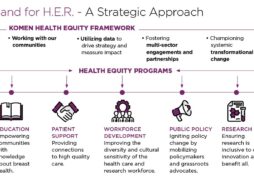A recent Washington Post article shared the experiences of patients who wanted to “go flat” rather than undergoing breast mound reconstruction after mastectomy. The article examined how sentiment toward flat closure has changed over time. Despite growing awareness, many patients report their doctors never spoke to them about the option to go flat or even actively tried to persuade them to have reconstructive surgery.
To provide additional perspective, Susan G. Komen reached out to Katrin van Dam, author of the recently-published book, Flat and Happy: Mastectomy and Flat Closure – A Personal, Practical Guide. Kat underwent a double mastectomy with flat closure after being diagnosed with bilateral invasive breast cancer in 2019.

Here is what she shared about her experience of going flat and what she learned in writing “Flat and Happy”:
I’m so pleased to see this new article raising awareness about the choice to go flat. As soon as it came out, my inbox started blowing up—I haven’t seen anything like it since Danica Patrick revealed she was having her breast implants removed. My friends knew I’d be excited because I’ve spent the last three years obsessing over this topic. In writing “Flat and Happy,” I wanted to ensure that every patient undergoing a mastectomy would know that going flat was an option. As I wrote in the introduction, I was compelled to write the book because:
I thought losing my breasts would be hard, and it’s turned out to be surprisingly easy. Because women confronting mastectomy need to be aware that choosing to go flat could potentially save them a lot of pain and difficulty. Because I want to help women understand that a doctor’s opinion about reconstructions is only that: an opinion. And because I now know that all too many women have reconstruction because they don’t realize there’s an alternative.
Katrin Van Dam
In discussions with my own surgeon, I was the one who raised the possibility of going flat. Whenever she talked about my surgical options, the words “with reconstruction” were always tacked on after “mastectomy.” And in interviewing scores of fellow flatties, I’ve discovered that my experience is far from unusual. I can’t tell you how many times I heard, “my doctor never mentioned that going flat was an option.”
This omission during the surgical consult is regarded by researchers as the mildest form of a phenomenon known as “flat denial.” Even more troublingly, a surgeon’s pro-reconstruction bias may impact the actual surgical outcome. In their FAQ, the advocacy organization Not Putting on a Shirt defines flat denial as, “when a surgeon’s unilateral actions deny their patient the agreed upon flat mastectomy result—either through negligence or intentional disregard. The patient is left with an egregiously poor cosmetic result with significant excess tissue that can only be remedied with additional surgery.”
For readers commenting on the Washington Post article, the fact that not all doctors are supportive of patients’ choice to go flat seems to have come as something of a bombshell revelation. Especially in this moment when having a uterus puts you at the mercy of legislatures around the country, they found it deeply troubling that many have to fight to get the surgical outcome they want. This fact is not shocking to members of the flat community, who see it every day, but it is still deeply troubling to us. So what is to be done?
Dr. Camelia Lawrence, my wonderful medical advisor for the book (and recipient of the Inaugural Susan G. Komen More Than Pink Honor for her commitment to breast cancer care) is doing her part to change the conversation about reconstruction. In her foreword she writes, “Over the years, I have had to confront my own bias in favor of reconstruction. So often the preferences of the patient (the most important person) are lost in the preoperative discussion.” When speaking with her mastectomy patients, Dr. Lawrence makes a point of reviewing the full range of options: they can either undergo breast mound reconstruction or they can opt for a flat closure. Both possibilities are treated equally, and patients are informed of the pros and cons of each choice.
I look forward to the day when flat closure is automatically offered to every patient, and everyone who goes flat gets a smooth, clean closure. But until that day, those who want to go flat may need to step outside their comfort zones in order to advocate for that outcome. I don’t mean to imply that if patients are denied the flat closure they want it is somehow their fault. Far from it. My point is that, if they know that flat denial is a possibility, there are things they can do to improve the chances that they will be happy with the outcome of their surgery.
The first step is to have a clear and frank discussion with one’s surgeon (Chapter 8 of my book provides a roadmap for this conversation). And by discussion, I mean that both parties are talking and listening. If you find that your doctor isn’t hearing you or is trying to impose his or her own beliefs about reconstruction on you, you need to trust your gut and speak up for what you want, no matter how awkward that may feel. And if your doctor still doesn’t wholeheartedly support your decision, you need to find one who does (Not Putting on a Shirt maintains a list of flat-friendly surgeons).
Self-advocacy isn’t easy. Questioning the person who is tasked with saving your life can be deeply uncomfortable. But it is the best tool we have, not only for self-protection but for changing the larger societal narrative. Should you find yourself needing to have these difficult conversations, you may find it helpful to bring along resources like the Washington Post article to share with your medical team. I’ve even heard from readers of my book that, after reading it, they’ve passed it on to their doctors so they can better support their patients who are making mastectomy-related decisions! As I like to say, we will change the world… one mind at a time.



